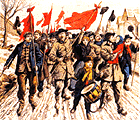|
|
|
|
Rise & fall of coal-mining |
|
|
Big
companies develop the pits |
 19th century coal mine with its rows of miners' houses, canal, and new railway line in the background. Slag heaps are piling up on the other side of the canal. |
Big companies develop
the pits Company towns |
|
|
French writer Emil Zola graphically described the harsh life of the miners in the “corons”. The company manager kept a vigilant eye on everything to avoid trouble with their ignorant and brutalised workforce. He closed the gates to the town at night. He could visit any cottage to check who was there, if there was a crucifix on the wall... He checked if miners went to Mass, where the priest threatened the wrath of God for those who caused trouble ... Their were educated at the company school, were discipline was harsh and they were taught to be obedient. |
||
 March of strikers |
Poverty and the
rise of Socialism |
|
|
Wartime and the
Depression of the '30s |
|
|
|
|
||
 Advertisement for miners - in the ’fifties they briefly enjoyed status as the best-paid workers  Slag heap - rubbish left behind by the mining era, now finding new uses. |
Closing the
pits But as in Britain, by the ’sixties coal-mining in northern France was losing money. Cheap oil took over most of the markets for expensive deep-mined coal: electric trains replaced coal-fired steam locomotives; natural gas replaced the old gasworks; France started to generate nuclear electricity on a big scale. As part of a European plan - the "European Coal & Steel Community", a fore-runner of the EU - the pits were helped to close down gradually. This plan gave the coal-mining communities time - and generous financial help - to attract new industries so ex-miners and their children could find other work.The last pit closed in 1990. Change was a painful process. Mining left
behind a depressing, dirty, carelessly exploited environment
- but you'll see for yourself how it is turning out... |
|
|
...... |
<-How coal was formed...... |
|
|
Places
to visit: |
|
Related background
information |
|
|
|
|
|
|







